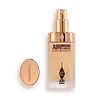Charlotte Tilbury Airbrush Flawless Foundation Versus Sculpted by Aimee Satin Silk Longwear Foundation
What's inside
What's inside
 Key Ingredients
Key Ingredients

 Benefits
Benefits

 Concerns
Concerns

 Ingredients Side-by-side
Ingredients Side-by-side

Water
Skin ConditioningCyclopentasiloxane
EmollientIsododecane
EmollientPEG-10 Dimethicone
Skin ConditioningPropanediol
SolventPolyglyceryl-4 Isostearate
EmulsifyingSilica
AbrasiveNylon-12
Phenoxyethanol
PreservativeDisteardimonium Hectorite
StabilisingPolysorbate 20
EmulsifyingDimethyl Isosorbide
SolventDimethicone Crosspolymer
Emulsion StabilisingTriethoxycaprylylsilane
Menthyl PCA
HumectantSodium Dehydroacetate
PreservativeArginine PCA
HumectantAluminum Hydroxide
EmollientTocopheryl Acetate
AntioxidantParfum
MaskingIsomalt
HumectantSodium Phytate
Phaeodactylum Tricornutum Extract
HumectantAcetyl Tetrapeptide-11
Skin ConditioningAcetyl Tetrapeptide-9
Skin ConditioningAlcohol
AntimicrobialPhytol
EmollientAlpha-Isomethyl Ionone
PerfumingBenzyl Salicylate
PerfumingCitronellol
PerfumingLimonene
PerfumingCI 77891
Cosmetic ColorantIron Oxides
Water, Cyclopentasiloxane, Isododecane, PEG-10 Dimethicone, Propanediol, Polyglyceryl-4 Isostearate, Silica, Nylon-12, Phenoxyethanol, Disteardimonium Hectorite, Polysorbate 20, Dimethyl Isosorbide, Dimethicone Crosspolymer, Triethoxycaprylylsilane, Menthyl PCA, Sodium Dehydroacetate, Arginine PCA, Aluminum Hydroxide, Tocopheryl Acetate, Parfum, Isomalt, Sodium Phytate, Phaeodactylum Tricornutum Extract, Acetyl Tetrapeptide-11, Acetyl Tetrapeptide-9, Alcohol, Phytol, Alpha-Isomethyl Ionone, Benzyl Salicylate, Citronellol, Limonene, CI 77891, Iron Oxides
Water
Skin ConditioningDimethicone
EmollientTitanium Dioxide
Cosmetic ColorantMica
Cosmetic ColorantDipropylene Glycol
HumectantIsododecane
EmollientCetyl PEG/PPG-10/1 Dimethicone
EmulsifyingPhenyl Trimethicone
Skin ConditioningCaprylic/Capric Triglyceride
MaskingSilica
AbrasiveSodium Chloride
MaskingSodium Hyaluronate
HumectantTocopherol
AntioxidantEctoin
Skin ConditioningNiacinamide
SmoothingCentella Asiatica Extract
CleansingLauryl PEG-9 Polydimethylsiloxyethyl Dimethicone
Skin ConditioningDimethicone/Vinyl Dimethicone Crosspolymer
Skin ConditioningTriethoxycaprylylsilane
Phenoxyethanol
PreservativeSorbitan Isostearate
EmulsifyingAluminum Hydroxide
EmollientDisteardimonium Hectorite
StabilisingParaffin
PerfumingHexadecene
SolventSorbitan Sesquioleate
Emulsifying1,2-Hexanediol
Skin ConditioningOzokerite
Emulsion StabilisingMicrocrystalline Wax
Emulsion StabilisingPropylene Carbonate
SolventEthylhexylglycerin
Skin ConditioningDehydroacetic Acid
PreservativeMethicone
EmollientCyclotetrasiloxane
EmollientCyclopentasiloxane
EmollientBHT
AntioxidantCI 77491
Cosmetic ColorantCI 77492
Cosmetic ColorantCI 77499
Cosmetic ColorantWater, Dimethicone, Titanium Dioxide, Mica, Dipropylene Glycol, Isododecane, Cetyl PEG/PPG-10/1 Dimethicone, Phenyl Trimethicone, Caprylic/Capric Triglyceride, Silica, Sodium Chloride, Sodium Hyaluronate, Tocopherol, Ectoin, Niacinamide, Centella Asiatica Extract, Lauryl PEG-9 Polydimethylsiloxyethyl Dimethicone, Dimethicone/Vinyl Dimethicone Crosspolymer, Triethoxycaprylylsilane, Phenoxyethanol, Sorbitan Isostearate, Aluminum Hydroxide, Disteardimonium Hectorite, Paraffin, Hexadecene, Sorbitan Sesquioleate, 1,2-Hexanediol, Ozokerite, Microcrystalline Wax, Propylene Carbonate, Ethylhexylglycerin, Dehydroacetic Acid, Methicone, Cyclotetrasiloxane, Cyclopentasiloxane, BHT, CI 77491, CI 77492, CI 77499
Ingredients Explained
These ingredients are found in both products.
Ingredients higher up in an ingredient list are typically present in a larger amount.
Aluminum Hydroxide is a form of aluminum. It can be naturally found in nature as the mineral gibbsite. In cosmetics, Aluminum Hydroxide is used as a colorant, pH adjuster, and absorbent.
As a colorant, Aluminum Hydroxide may add opacity, or reduce the transparency. Aluminum hydroxide is contains both basic and acidic properties.
According to manufacturers, this ingredient is an emollient and humectant. This means it helps hydrate the skin.
In medicine, this ingredient is used to help relieve heartburn and help heal ulcers.
There is currently no credible scientific evidence linking aluminum hydroxide in cosmetics to increased cancer risk.
Major health organizations allow the use of aluminum hydroxide in personal care products and have not flagged it as a carcinogenic risk at typical usage levels.
Learn more about Aluminum HydroxideCyclopentasiloxane, or D5, is a silicone used to improve texture of products and trap moisture.
D5 is considered lightweight and volatile. Volatile means it evaporates quickly after application. Once evaporated, D5 leaves a thin barrier that helps keep skin hydrated.
It is also an emollient. Emollients help soften the skin and prevent water loss. Silicones create a silky texture in products. D5 helps other ingredients become more spreadable.
Studies show D5 is safe to use in skincare products. We recommend speaking with a skincare professional if you have concerns.
Learn more about CyclopentasiloxaneDisteardimonium Hectorite comes from the clay mineral named hectorite. It is used to add thickness to a product.
It can also help stabilize a product by helping to disperse other ingredients.
Hectorite is a rare, white clay mineral.
Learn more about Disteardimonium HectoriteIsododecane is a fragrance, emollient, and solvent.
As an emollient, it helps your skin stay soft and hydrated. Emollients help trap moisture into your skin.
Isododecane's role as a solvent makes it a great texture enhancer. It spreads smoothly on skin and does not leave a sticky feeling behind. Isododecane also helps prevent color transfer in makeup products.
Isododecane is not absorbed into skin.
Learn more about IsododecanePhenoxyethanol is a preservative that has germicide, antimicrobial, and aromatic properties. Studies show that phenoxyethanol can prevent microbial growth. By itself, it has a scent that is similar to that of a rose.
It's often used in formulations along with Caprylyl Glycol to preserve the shelf life of products.
Silica, also known as silicon dioxide, is a naturally occurring mineral. It is used as a fine, spherical, and porous powder in cosmetics.
Though it has exfoliant properties, the function of silica varies depending on the product.
The unique structure of silica enhances the spreadability and adds smoothness, making it a great texture enhancer.
It is also used as an active carrier, emulsifier, and mattifier due to its ability to absorb excess oil.
In some products, tiny microneedles called spicules are made from silica or hydrolyzed sponge. When you rub them in, they lightly polish away dead skin layers and enhance the penetration of active ingredients.
Learn more about SilicaTriethoxycaprylylsilane is a silicone used to bind and stabilize ingredients.
As an emulsifier, it helps prevent ingredients from separating. This can help elongate the shelf life of products.
Triethoxycaprylylsilane is often used to coat mineral sunscreens ingredients to help give a better feel. It also helps reduce oxidative stress in sunscreens.
Learn more about TriethoxycaprylylsilaneWater. It's the most common cosmetic ingredient of all. You'll usually see it at the top of ingredient lists, meaning that it makes up the largest part of the product.
So why is it so popular? Water most often acts as a solvent - this means that it helps dissolve other ingredients into the formulation.
You'll also recognize water as that liquid we all need to stay alive. If you see this, drink a glass of water. Stay hydrated!
Learn more about Water